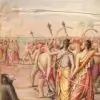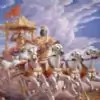About Mahavir Jayanti
Mahavira, also known as Vardhamana, is the last one in the galaxy of Twenty-four Teerthankaras (Jain Prophets). He was born in the year 599 B.C. and has been acclaimed as one of the greatest prophets of peace and social reformation that Bharat has ever produced. He was born to a pious couple, Siddhartha and Priyakarani or popularly Trishala Devi - who were deeply permeated with the philosophy of jainism preached by Parswanatha, the 23rd Teerthankara. Siddhartha was the king of Kaundinyapura on the outskirts of Vaishali (near Patna in Bihar).
Even as a boy, Mahavira came to be associated with many episodes of absolute fearlessness which earned him the name 'Mahavira'. He grew up as a prince, excelling in physical prowess as well as intellectual acumen. However, he renounced the pleasures and luxuries of the place, as also the power and prestige of kingship, and undertook a life of intense penance for more than twelve years. He calmly bore not only the rigors of nature but the torments from the ignorant and mischievous among his own countrymen also. He finally became self-illumined. But not content with his own personal salvation, he chose to become a great human redeemer.
He looked around and found the society corrupted by the distortions of the true concept of Dharma. Violence in the form of animal sacrifice had overshadowed the true spirit of yajna and yaga. Spiritual values had been supplanted by superstitions and lifeless rituals and dogmas. Propitiating various Gods and Goddesses was considered as a means of acquiring religious merit - Punya - to the exclusion of the true spiritual significance of these Vedic practices. Mahavira, with his penetrating insight born out of self-realization, struck mercilessly at these perversions. He simplified the religious procedures and concentrated on righteous conduct.
Mahavira's simple and convincing method of appealing to the highest and noblest impulses in the living breast soon won him a large following. He would, for example, pose the following question in order to bring home the grand message of non-injury to every living being: "Can you hold a red-hot iron rod in your hand merely because some one wants you to do so?" The listeners would instantly reply, "No, never". Then Mahavira would ask them, "Then, will it be right on your part to ask others to do the same thing just to satisfy your desire? If you cannot tolerate infliction of pain on your body or mind by others' words and actions, what right have you to do the same to others through your words and deeds?" Mahavira would then sum up his message: "Do unto others as you would like to be done by. Injury or violence done by your to any life in any form, animal or human, is as harmful as it would be if caused to your own self."
Mahavira's emphasis on this 'Unity of Life' forms one of the highest saving principles of human life. The modern civilization, which seeks to exploit and destroy every other kind of living species in order to satiate the never ending cravings of man, is landing the entire human species itself in a deadly peril.
As one deeply conversant with the needs, capacities and aptitudes of human being, Mahavira initiated a simple five-fold path for the householders: Ahimsa (Non-injury - physical or mental - to others), Asteya (non-stealing), Brahmacharya (temperance in sexual pleasures) and Aparigraha (non-acquisition of property).
Mahavira's injunctions for the monks and nuns were however very exacting. Abstinence from every kind of physical comfort and material possession and absolute dedication to the highest ethical and spiritual discipline were enforced. Even to this day, 2500 years after the passing away of that great master, this pure and upright tradition of the monks has been maintained. Thousands of white clad Sanyasins and Sanyasinis and also nude monks move on foot from village to village and town to town, throughout the length and breadth of the country, carrying Mahavira's gospel of peace, non-injury and brotherhood among people.
Happy Mahaveera Jayanti😃
































